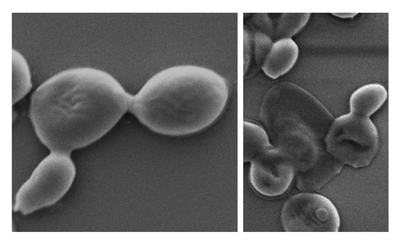RMIT researchers develop nanothin superbug killer

An antimicrobial coating developed by RMIT University researchers is effective against a broad range of drug-resistant bacteria and fungal cells, yet it leaves human cells unharmed.
The superbug-destroying coating is reported to be one of the thinnest coatings to date, and could be used on wound dressings and implants to prevent and treat potentially deadly bacterial and fungal infections.
Described in the American Chemical Society journal Applied Materials & Interfaces, the research team’s new coating is based on an ultrathin 2D material that until now has mainly been of interest for next-generation electronics.
Previous studies of black phosphorus (BP) have indicated it has some antibacterial and antifungal properties, but the current study reveals that BP is effective at killing microbes when spread in nanothin layers on surfaces like titanium and cotton, used to make implants and wound dressings.
Dr Aaron Elbourne, co-lead researcher and postdoctoral fellow in the School of Science at RMIT, said finding one material that could prevent both bacterial and fungal infections was a significant advance.
“These pathogens are responsible for massive health burdens and, as drug resistance continues to grow, our ability to treat these infections becomes increasingly difficult,” Dr Elbourne said. “We need smart new weapons for the war on superbugs, which don’t contribute to the problem of antimicrobial resistance.
“Our nanothin coating is a dual bug killer that works by tearing bacteria and fungal cells apart, something microbes will struggle to adapt to. It would take millions of years to naturally evolve new defences to such a lethal physical attack. While we need further research to be able to apply this technology in clinical settings, it’s an exciting new direction in the search for more effective ways to tackle this serious health challenge.”
Co-lead researcher Associate Professor Sumeet Walia, from RMIT’s School of Engineering, has previously led groundbreaking studies using BP for artificial intelligence technology and brain-mimicking electronics.
“BP breaks down in the presence of oxygen, which is normally a huge problem for electronics and something we had to overcome with painstaking precision engineering to develop our technologies,” Walia said.
“But it turns out materials that degrade easily with oxygen can be ideal for killing microbes — it’s exactly what the scientists working on antimicrobial technologies were looking for. So our problem was their solution.”
How the coating works
As BP breaks down, it oxidises the surface of bacteria and fungal cells. This process, known as cellular oxidisation, ultimately works to rip them apart.
In the new study, first author and PhD researcher Zo Shaw tested the effectiveness of nanothin layers of BP against five common bacteria strains, including E. coli and drug-resistant MRSA, as well as five types of fungus, including Candida auris.


In just two hours, up to 99% of bacterial and fungal cells were destroyed. Importantly, the BP also began to self-degrade in that time and was entirely disintegrated within 24 hours — an important feature that shows the material would not accumulate in the body.
The laboratory study identified the optimum levels of BP that have a deadly antimicrobial effect while leaving human cells healthy and whole.
The researchers have now begun experimenting with different formulations to test the efficacy on a range of medically relevant surfaces. The team is keen to collaborate with potential industry partners to further develop the technology, for which a provisional patent application has been filed.
AdPha welcomes "win for all Australians" PBS news
Advanced Pharmacy Australia has welcomed the announcement that over 400,000 Australians each week...
NSW sees ramping reductions across some of its busiest EDs
Some of NSW's busiest emergency departments have seen significant reductions in hospital...
RACGP calls for obesity-management medication PBS subsidy
Following its new position statement on obesity prevention and management, the RACGP is calling...









